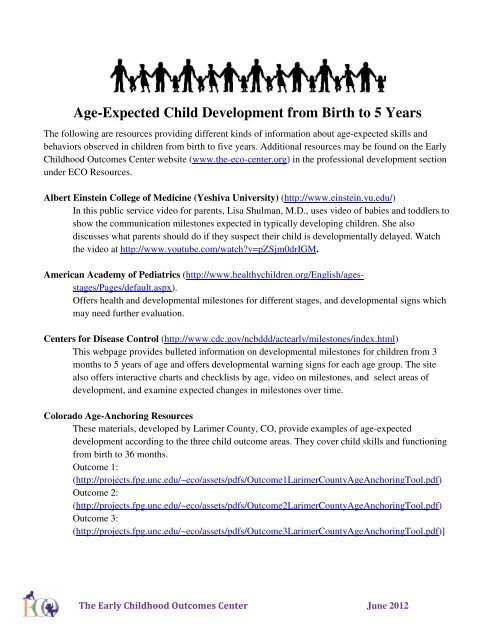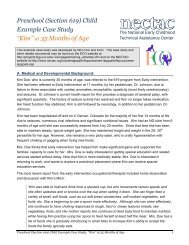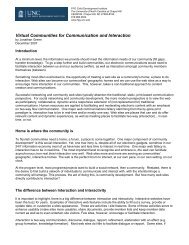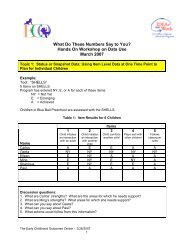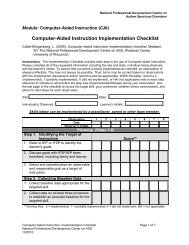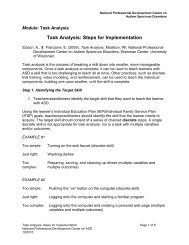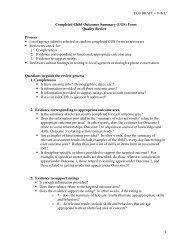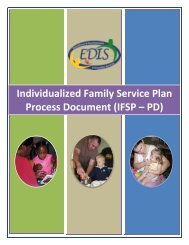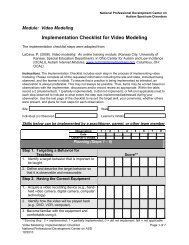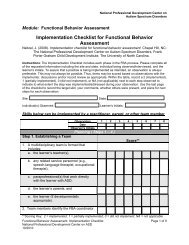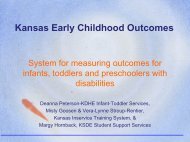Age-expected child development resources - FPG Child ...
Age-expected child development resources - FPG Child ...
Age-expected child development resources - FPG Child ...
Create successful ePaper yourself
Turn your PDF publications into a flip-book with our unique Google optimized e-Paper software.
<strong>Age</strong>-Expected <strong>Child</strong> Development from Birth to 5 Years<br />
The following are <strong>resources</strong> providing different kinds of information about age-<strong>expected</strong> skills and<br />
behaviors observed in <strong>child</strong>ren from birth to five years. Additional <strong>resources</strong> may be found on the Early<br />
<strong>Child</strong>hood Outcomes Center website (www.the-eco-center.org) in the professional <strong>development</strong> section<br />
under ECO Resources.<br />
Albert Einstein College of Medicine (Yeshiva University) (http://www.einstein.yu.edu/)<br />
In this public service video for parents, Lisa Shulman, M.D., uses video of babies and toddlers to<br />
show the communication milestones <strong>expected</strong> in typically developing <strong>child</strong>ren. She also<br />
discusses what parents should do if they suspect their <strong>child</strong> is <strong>development</strong>ally delayed. Watch<br />
the video at http://www.youtube.com/watch?v=pZSjm0drIGM.<br />
American Academy of Pediatrics (http://www.healthy<strong>child</strong>ren.org/English/agesstages/Pages/default.aspx).<br />
Offers health and <strong>development</strong>al milestones for different stages, and <strong>development</strong>al signs which<br />
may need further evaluation.<br />
Centers for Disease Control (http://www.cdc.gov/ncbddd/actearly/milestones/index.html)<br />
This webpage provides bulleted information on <strong>development</strong>al milestones for <strong>child</strong>ren from 3<br />
months to 5 years of age and offers <strong>development</strong>al warning signs for each age group. The site<br />
also offers interactive charts and checklists by age, video on milestones, and select areas of<br />
<strong>development</strong>, and examine <strong>expected</strong> changes in milestones over time.<br />
Colorado <strong>Age</strong>-Anchoring Resources<br />
These materials, developed by Larimer County, CO, provide examples of age-<strong>expected</strong><br />
<strong>development</strong> according to the three <strong>child</strong> outcome areas. They cover <strong>child</strong> skills and functioning<br />
from birth to 36 months.<br />
Outcome 1:<br />
(http://projects.fpg.unc.edu/~eco/assets/pdfs/Outcome1LarimerCounty<strong>Age</strong>AnchoringTool.pdf)<br />
Outcome 2:<br />
(http://projects.fpg.unc.edu/~eco/assets/pdfs/Outcome2LarimerCounty<strong>Age</strong>AnchoringTool.pdf)<br />
Outcome 3:<br />
(http://projects.fpg.unc.edu/~eco/assets/pdfs/Outcome3LarimerCounty<strong>Age</strong>AnchoringTool.pdf)]<br />
The Early <strong>Child</strong>hood Outcomes Center June 2012
First Signs (http://www.firstsigns.org/healthydev/healthydev.htm)<br />
First Signs is a public awareness and training program addressing early detection and<br />
intervention of autism and other <strong>development</strong>al disorders. This site provides information on<br />
monitoring <strong>development</strong>, typical milestones, video clips of <strong>child</strong>ren with ASD, and tips on<br />
sharing concerns.<br />
Illinois <strong>Child</strong> Development Modules: Understanding Young <strong>Child</strong>ren's Development<br />
Two narrated modules were developed by training personnel in Illinois based on content<br />
developed by the University of Connecticut Center for Excellence in Developmental Disabilities.<br />
The modules correspond to the <strong>child</strong> outcome areas and are focused on identifying ageappropriate<br />
skills:<br />
o Understanding Young <strong>Child</strong>ren's Development: A Focus on Positive Social<br />
Emotional Skills (https://ucpnet.adobeconnect.com/_a47435447/p59659093/)<br />
o Understanding Young <strong>Child</strong>ren's Development: Acquiring and Using Knowledge<br />
and Skills (https://ucpnet.adobeconnect.com/_a47435447/p9bq60bntyx/)<br />
Infant and Toddler Connection of Virginia<br />
For <strong>child</strong>ren birth to age three:<br />
(http://cte.jhu.edu/onlinecourses/HealthyBeginnings/HBFINAL.pdf)<br />
Maryland's Part C <strong>Age</strong>-Anchored Early Learning Guidelines<br />
For <strong>child</strong>ren birth to age three:<br />
(http://cte.jhu.edu/onlinecourses/HealthyBeginnings/HBFINAL.pdf<br />
The National Institute on Deafness and Other Communication Disorders<br />
(http://www.nidcd.nih.gov/health/voice/speechandlanguage.asp)<br />
This site provides background information on speech and language <strong>development</strong> from birth to 5<br />
years. Interactive checklists for different ages are available.<br />
North Dakota DPI <strong>Age</strong> Expectation Developmental Milestones<br />
(http://www.dpi.state.nd.us/speced1/<strong>child</strong>hood/full_version%20.pdf)<br />
This document was developed by North Dakota's Department of Public Instruction and presents<br />
age-<strong>expected</strong> functioning according to the three <strong>child</strong> outcomes. They also have a summary<br />
version- milestones by age group<br />
(http://www.dpi.state.nd.us/speced1/<strong>child</strong>hood/age_groups%20.pdf) and a three-page milestones<br />
quick reference (http://www.dpi.state.nd.us/speced1/<strong>child</strong>hood/quick_ref.pdf).<br />
The Early <strong>Child</strong>hood Outcomes Center June 2012
Parenting Counts Developmental Timeline http://www.parentingcounts.org/information/timeline/<br />
This online resource from Talaris Institute provides research-based information about <strong>child</strong>ren’s<br />
<strong>development</strong>al milestones from birth to age 5.<br />
Pathways (http://www.pathwaysawareness.org/awareness/healthcare-professionals/early-motorsurveillance/)<br />
An online resource for information and activities related to infant and <strong>child</strong> <strong>development</strong>.<br />
University of Connecticut Center for Excellence in Developmental Disabilities<br />
http://www.uconnucedd.org/<br />
An online training module on social-emotional <strong>development</strong> in infants and toddlers related to the<br />
three OSEP <strong>child</strong> outcomes.<br />
Zero to Three (http://www.zerotothree.org/<strong>child</strong>-<strong>development</strong>/)<br />
Brain <strong>development</strong>, challenging behaviors, mental health topics, play, social <strong>development</strong>,<br />
temperament, and more. Each section has interactive tools, parent handouts, tip Sheets, FAQ’s,<br />
articles, PowerPoint slides, and other <strong>resources</strong>.<br />
The Early <strong>Child</strong>hood Outcomes Center June 2012


